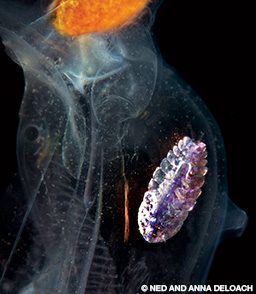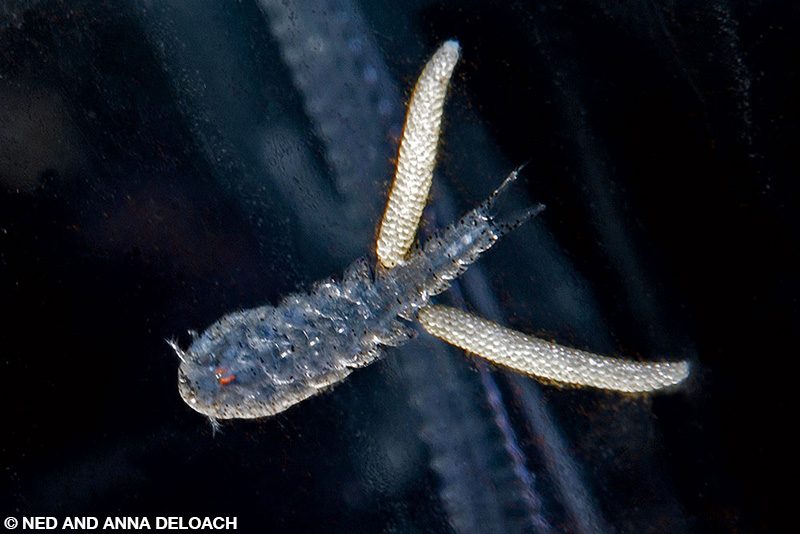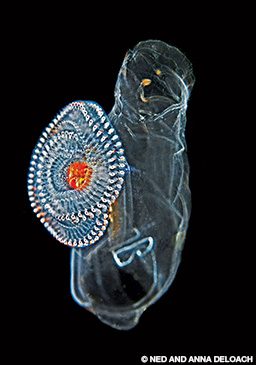The salon is empty as I come up from my cabin. Squinting through the morning glare, I see my shipmates outside along the starboard railing. Their pointing fingers are followed by rounds of applause, cheers and excited chatter. This behavior isn’t unusual on liveaboard voyages, especially in Raja Ampat, Indonesia, where marine life is often as exciting above water as below. It’s usually pods of porpoises or whale spouts that send everyone scrambling to the rails. But this gathering is different. Instead of looking out to sea, every eye is cast straight down.

Intrigued, I pour a cup of coffee and wedge into the lineup beside Anna. Glancing over, she grabs my arm and stammers, “Sapphirinas like I’ve never imagined are everywhere! Look!” Following the sweep of her arm, I see hundreds of golden flashes beneath the surface. “This must be what the Japanese call ‘jeweled water,’” she adds with a sigh.
Like many divers, Anna and I have occasionally caught glimpses of mysterious winks of bright color while underwater. We later learned that the flashes are the nuptial displays of lovelorn male copepods commonly known as sea sapphires. For fear of being picked off by predators while near the sunlit surface, the tiny crustaceans (measuring between 0.05 and 0.16 inches) have evolved a unique adaptation that allows them to attract mates one second and thwart predators the next by becoming transparent, which is as close to invisible as nature allows.
A study in 2015 explained how different angles of light reflecting off stacked layers of honeycombed crystals create the ephemeral panoply of colors, which includes gold and blue-green iridescence. When the light’s angle descends into the lower wavelengths, the sea sapphires spontaneously disappear.

Copepods are one of the most abundant groups of animals in the ocean and a key component of the food web. Along with an assortment of oceanic creatures, they make vertical migrations from the depths each evening to feed near the surface under the cover of darkness — except for those in the genus Sapphirina, which alter their schedule to mate in the morning sunlight.

Almost everyone, except possibly Anna, has forgotten about the sea sapphires by the time we tumble over the sides of our dinghy and head for an outcropping where we plan to ride the current along a sloping reef line. Rounding the point, our group is whisked into a undersea dreamscape bewitched by blinking males stretching as far as the eye can see.
Our dive becomes a breathtaking bluewater drift among not only impassioned copepods but also salps. These pelagic relatives of bottom-dwelling tunicates float past in see-through pods and attach together in long, glistening chains. We are swimming in a salp bloom, precipitated by a phytoplankton bloom, which is the gelatinous vegetarians’ favorite food. And as we are about to discover, the sudden wealth of salps plays a pivotal role in the sea sapphires’ love life.
I impulsively attempt to photograph the winking copepods, which promptly turns into an exercise in frustration. A tug on my fin breaks my concentration. Anna holds up her slate with a single bold word: females. She nods toward Wendy Brown, our cruise director, hovering near the surface. As I arrive, Wendy points toward a salp with a female Sapphirina inside with two streaming egg sacs. A brief survey reveals numerous females riding inside the salps and tiny males occasionally clinging to the outside. Things happen rapidly in the reproductive world of Sapphirinas. Researchers in an aquarium setting have recorded females mating, producing eggs, and then, along with their hatchlings, consuming the salps’ organs before abandoning the premises, all within 48 hours.

My attention shifts to the ubiquitous open-ended, barrel-shaped salps that move about by drawing in water along with phytoplankton, which are filtered with a centrally located feeding net. The scheme works to perfection: Fueled by phytoplankton, salps have one of the fastest growth rates and most rapid generational turnovers of any multicellular animal.
The salps’ two-part reproductive cycle orchestrates the unprecedented production. Single embryos, sexually produced inside the central canals of fertilized females, increase in length by up to an astounding 20 percent an hour. After leaving home and floating free, each pod soon asexually produces a spiraling chain consisting of up to 100 miniature adults. At their peak, blooms can increase populations by 250 percent a day until the phytoplankton are devoured. Without food the salps starve in short order and sink, taking a payload of atmospheric carbon to the seafloor. By luck, we are swimming through one of the ocean’s phenomenal boom-and-bust cycles, with Sapphirinas highlighting the unforgettable affair.
Eager to repeat the experience, we go back to the site after lunch. To our chagrin, only a scattering of salps remains, and the jeweled water is gone — vanishing as quickly as it appeared.
Explore More
Learn more about sea sapphires in this video.
© Alert Diver — Q4 Fall 2019